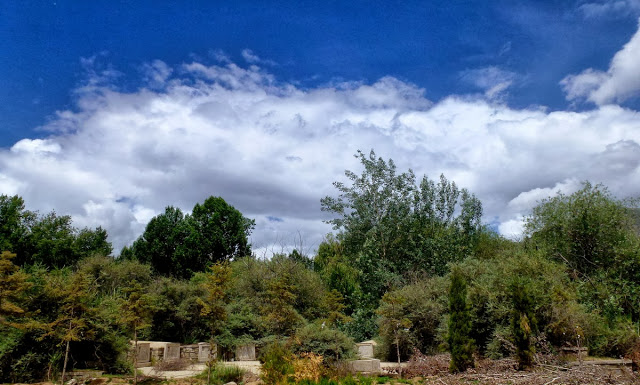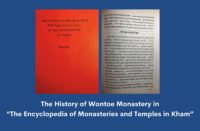High Peaks Pure Earth has translated a blogpost by Woeser written in August and September 2013 for the Mandarin and Tibetan services of Radio Free Asia and published on her blog on September 22, 2013.
This post by Woeser is an extended version of the previous piece titled “The ‘Martyrs Graveyard’ in the Western Suburbs of Lhasa” and goes into more detail on historical incidents that took place in Lhasa during the Cultural Revolution.
“Lhasa’s ‘Red Guards Graveyard’ and the Tibetan Cultural Revolution Controversy”
By Woeser
On the first day of July, we went to the “Martyrs Graveyard”, which is not too far away from Drepung Monastery. In its vicinity there are quite a few large military barracks, which belong to the Tibetan air force and other military troops directly subordinate to the Chengdu Military Area. Many years ago, this place used to be verdant and lush gardens, it perhaps belonged to Drepung Monastery or the nearby Nechung Monastery. Today, apart from military barracks, many high-rises have been erected; the question is, why would an urban developer establish a residential area next to a graveyard?
Of course, this has not always been a graveyard, it could only have appeared within the last few decades. I found the following related information on the internet: “It was built in 1955 and repaired in 1991”; “buried here are over 800 martyrs who bravely sacrificed their lives for the peaceful liberation of Tibet, for the building of the Sichuan-Tibetan Highway, for putting down rebellions, for fighting in the Sino-Indian counterattack in self-defense, for helping solving the Lhasa riots and for developing and building up Tibet; the place is referred to as the Autonomous Region’s national defense education base and the Ministry of Civil Affairs patriotic education base”; “in order to enhance the patriotic spirit, the martyrs graveyard is being turned into a red scenic spot of Lhasa”; “it has already been added to the national level of red scenic spots and has received investments of 16.41 million Yuan”.

So we went to the “Martyrs Graveyard” where they are currently carrying out large-scale construction. The “red scenic spot” project was contracted out to Jinhui Construction Engineering Co. Ltd. from Jiangxi Province; the sign with the project summary hanging on the outside wall tells us that the project is expected to be completed at the end of October; among the 11 representatives of the construction department, design department, supervision department, logistics department, building department etc, I only saw one single Tibetan name, all others were Chinese.
According to the introduction to the “Martyrs Graveyard”, over 2000 graves would be divided into 4 areas: martyrs graveyard; cadres graveyard; common people’s graveyard; and “Cultural Revolution” graveyard. “The ‘Cultural Revolution’ graveyard is situated in the northwestern corner of the martyrs memorial pavilion. It includes 74 graves mainly occupied by people who died during the violent struggle inside the Jokhang Temple.” These words really surprised me. I have been to this “Cultural Revolution” graveyard many times before, I have researched and written about the Cultural Revolution in Tibet and as far as I know, there are only 12 graves of people who died in the Jokhang during the Cultural Revolution and those 12 people were all Red Guards and all of them were young Tibetans.
Of course, it was by no means only 12 or 74 people who died during the Cultural Revolution in Lhasa; and these people were not only Tibetans or students. During the Cultural Revolution, Chinese and Tibetans and other ethnic groups stood together in never-seen-before unity, changing the saying “intimacy is decided by class” into “intimacy is decided by faction”, ethnic problems were of course insignificant. Just as it was the case with those 12 Red Guards, their ages ranged from 17 to 36, 3 of them were female, 9 male, all of them were killed by PLA bullets inside or outside the Jokhang; and this was not for ethnic reasons, it was part of the mass killings during the Cultural Revolution.
Walking amongst the overgrown weeds of the “Cultural Revolution” graveyard, every dilapidated grave and writing etched on them had become blurred, I photographed each one again, one by one. It here thirteen years ago that I had stood in front of the graves of 12 young Tibetans, talking about the indistinct past events that led to their deaths. Wang Lixiong encouraged me to write a book about the Cultural Revolution in Tibet based on the photographs taken by my father so as to recover history’s truth as much as possible.
 At the time one could still see that this graveyard was once highly valued, it was surrounded by a high wall with 12 circular-shaped tombs being positioned around a small cement square. In its middle there was a flower bed and a street light. Also, every one of these graves was carefully and delicately designed with a photo of the deceased being embedded within the gravestone. When I was there, however, the place was already grown over with weeds and on the damaged square the fodder of livestock was piled up; the gravestones were broken and the inscriptions could hardly be recognised. Only with great difficulties could one decipher what was written on them: the first line read “A martyr who died during the political incident at Jokhang Temple in 1968 (6/7)”. After that there was the name of the victim, his place of birth and his age. If it was a woman it would be especially indicated. At the end it said “Tibet Autonomous Region Revolutionary Committee of the Tibetan Military Area, August 1968”.
At the time one could still see that this graveyard was once highly valued, it was surrounded by a high wall with 12 circular-shaped tombs being positioned around a small cement square. In its middle there was a flower bed and a street light. Also, every one of these graves was carefully and delicately designed with a photo of the deceased being embedded within the gravestone. When I was there, however, the place was already grown over with weeds and on the damaged square the fodder of livestock was piled up; the gravestones were broken and the inscriptions could hardly be recognised. Only with great difficulties could one decipher what was written on them: the first line read “A martyr who died during the political incident at Jokhang Temple in 1968 (6/7)”. After that there was the name of the victim, his place of birth and his age. If it was a woman it would be especially indicated. At the end it said “Tibet Autonomous Region Revolutionary Committee of the Tibetan Military Area, August 1968”.
After 7 years of research and writing, I came to know that this was the most shocking case of murder during the Cultural Revolution in Tibet. In a nutshell, the Cultural Revolution engulfed the TAR in the same way that it engulfed the whole of China; it was also home to the rebel faction that had started as a “cultural struggle” and then turned into a “violent struggle” and that was split into two completely incompatible but in essence very similar groups: the “rebel faction” and the “conservative faction”. The Jokhang was occupied by “rebels”. The room facing the street to the left on the third floor was used as their broadcasting station; countless “rebels” were stationed there to defend it (most of them were local Red Guards from the resident committee and the factories, there were also some local enthusiasts and Red Guards from Lhasa Middle School). It is said that this broadcasting station was carrying out fierce propaganda campaigns, which is why on June 7, 1968, the PLA, that was supporting the “conservative faction”, attacked the Jokhang with guns, leaving many casualties.
The “Historical Tibetan Communist Party Records of Major Events” published in 1995, described this event in only one sentence: “Troops of the 6th and 7th Lhasa garrison entered the Jokhang that had been occupied by communal organisations but they were obstructed and it came to a conflict with casualties.”
In fact, during this blood-reeking murder case, 10 people died inside the Jokhang and two were killed in the streets right outside. They were about 20 year old Red Guards from the Hebaling and Banak Shol neighbourhood committees. I heard from people who witnessed the event that back then they could hear the sounds of gunfire: “dadadadada”; and they also heard the broadcasting station giving out the message that “the rebels have been attacked!” The fighting was over very quickly, the number of injured people exceeded those that died; they were randomly thrown onto carriages and transported to the entrance of the Tibetan Hospital.
 This event at the Jokhang caused a storm of protest in Lhasa, it even affected Beijing. Mao Zedong and Lin Biao criticised the local officials for this action, condemning the military for “supporting one faction, but suppressing the other”. Respective officials of the Tibetan military apologised to the “rebel faction”, some were even punished. The “rebels” gave a detailed report on the event in the “Red Rebel Magazine” and even made a badge showing Mao Zedong criticising the local officials. They also held large-scale demonstrations and the deceased were pompously buried in the “Martyrs Graveyard” in Lhasa, where they established a small park especially for them.
This event at the Jokhang caused a storm of protest in Lhasa, it even affected Beijing. Mao Zedong and Lin Biao criticised the local officials for this action, condemning the military for “supporting one faction, but suppressing the other”. Respective officials of the Tibetan military apologised to the “rebel faction”, some were even punished. The “rebels” gave a detailed report on the event in the “Red Rebel Magazine” and even made a badge showing Mao Zedong criticising the local officials. They also held large-scale demonstrations and the deceased were pompously buried in the “Martyrs Graveyard” in Lhasa, where they established a small park especially for them.
Initially, the deceased were recognised as martyrs, but one year later they were dismissed as people whose “death cannot wipe out their crimes”. Their coffins were dug up and their bodies were ruthlessly left outside. The husband of an injured broadcaster said when interviewed by me: “Back then, when I went to the graveyard to have a look, five or six graves had already been opened, the bodies were rotten to the bones, maggot-eaten with flies buzzing around them. A few bodies were later reclaimed by the respective families; the remaining ones were buried again. Tibetans never had the tradition of burying the dead, but we had to do it like that back then because they were said to be martyrs. But in the end, they were still treated in such a devastating way…” He choked, he could not continue his story.
45 years have passed since, it is said that not a single person has ever come to pay a visit to these 12 Red Guards who had died such a violent death. Even though Tibetans don’t entertain the custom of tomb sweeping and offering sacrifice to the dead, but the respective work units should really come and look after these 12 graves when they offer sacrifices for other deceased inside the “Martyrs Graveyard”. However, the whys and wherefores of this event have never been dealt with in any public texts; even the wording “7/6 Jokhang Temple Incidents, Lhasa 1968” is never openly mentioned, to the point that the event itself is on the verge of being buried forever.
August – September, 2013







Follow Us!